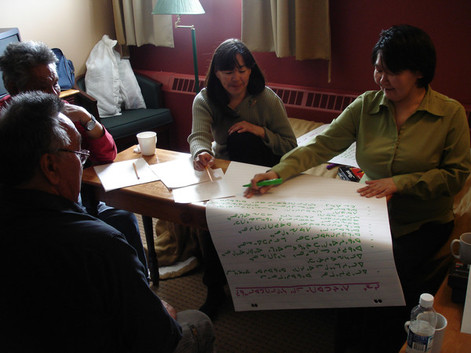Inuktitut Language
The Inuktituurniup Saturtauninga Project
This project begun when the negotiators of the Nunavik Aquvvinga autonomous government requested a report on measures to protect minority languages (rapport). A second phase of the project assessed the language situation in Nunavik in light of measures in force in other parts of the world. However, the research team concluded that a valid assessment could only come from the communities themselves, and so a series of local workshops were integrated into the project.
The Inuit of Nunavik expressed growing concern for the survival of Inuktitut, and in response, Avataq Cultural Institute, with the support of Nunavik Aquvvinga and Makivik Corporation, launched the Inuktituurniup Saturtauninga project. The project’s objectives are to prevent the erosion of the Inutitut language and to ensure that, in a milieu dominated by English and French, it maintains its position as the main language shared by the majority of the population of Nunavik.
Avataq realized that the first step required was to undertake a careful evaluation of the actual state of the Inuit language. Before determining what measures are necessary to ensure the survival of Inuktitut, who will apply such measures and how it will be done, we need to answer three strategic questions:
What exactly is the condition of the Inuktitut language today?
What are its strengths?
What factors are harming it?
Methodology
To direct this work, representatives from the Kativik School Board (KSB), Makivik Corporation and Avataq Cultural Institute formed the Inuktituurniup Saturtauninga planning committee.
Rather than calling upon external consultants and experts to undertake the evaluation, the members of the planning committee decided to work directly with the people most affected by the process – the Inuit of Nunavik.
In order to ensure that the Inuit of Nunavik were involved from the very beginning of the process, the planning committee adopted a community-based procedure that has been used successfully for some ten years in many Kativik School Board (KSB) schools, and that conforms with the policies recommended by both the Quebec Ministry of Education and the Organization for Economic Cooperation and Development (OECD).
Over the years, a KSB team of three animators have acquired considerable experience in Nunavik schools in the utilization of this methodology, and the planning committee has decided to invite them to organize and animate linguistic workshops in the communities.
The methodology involves holding a series of workshops, during which interveners from the community can:
1) assess the current state of things through discussion of the strategic questions;
2) establish their own steering committee to define priorities, then develop a realistic action plan and put it in place; and
3) evaluate and adjust their actions on an ongoing basis.

